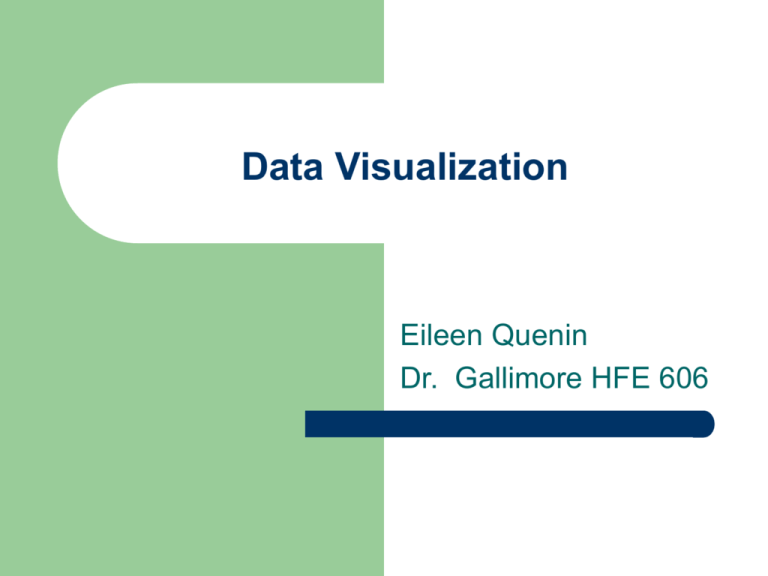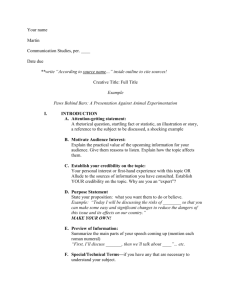Data Visualization - College of Engineering and Computer Science
advertisement

Data Visualization Eileen Quenin Dr. Gallimore HFE 606 Introduction What is Data Visualization? How does Data Visualization Work? – – – – History -Jacques Bertin Image Theory “Image” a definition Data Visualization and its use today What are the benefits of Data Visualization? Examples of Data Visualization Conclusion References What is Data Visualization Data visualization is the process of converting raw data into easily understood pictures of information that enable fast and effective decisions. Early in the 20th-century, gestalt psychologists observed that when elements were gathered into a figure, the figure took on a perceptual salience that exceeded the sum of its parts; Data -> Easily Understood Pictures Jacques Bertin who wrote the classic works of graphical visualization “Semiology of Graphics” states that the “transformation from numbers to insight requires two stages.” Data/Processes Image Algorithm Perception Insight Bertin’s 7 Visual Variables Seven Visual Variables position – form – orientation – color – texture – value – size combined with a visual semantics for linking data attributes to visual elements – Image Theory Visual Processing occurs in 3 steps. – – – 1) formation of the retinal image, 2) decomposition of the retinal image information into an array of specialized representations and 3) reassembly of the information into object perception. Image Bertin's key concept is the image, from which the theory derives its name. Roughly speaking, an image is the fundamental perceptual unit of a visualization. – An ideal visualizations will contain only a single image in order to optimize "efficiency," the speed with which observer can extract the information Uses Today Data-driven actions are increasingly made without access to information provided by traditional information presentation Information visualization is emerging as an important fusion of graphics, scientific visualization, database, and human-computer interaction. In Military, Commercial Industries use Data Visualization to convey complex results as understandable images. What is Data Visualization Data visualization is used in software applications to provide an intuitive graphical interface. It is applied to many areas to enable users to glean useful information from their data for faster, more informed decision making. These areas include: Military, private business sectors and scientific research. What are the benefits of Data Visualization? Data visualization allows users see several different perspectives of the data. Data visualization makes it possible to interpret vast amounts of data Data visualization offers the ability to note exceptions in the data. Data visualization allows the user to analyze visual patterns in the data. Exploring trends within a database through visualization by letting analysts navigate through data and visually orient themselves to the patterns in the data. Benefits Data visualization can help translate data patterns into insights, making it a highly effective decision-making tool. Data visualization equips users with the ability to see influences that would otherwise be difficult to find. With all the data available, it is difficult to find the nuances that can make a difference. By simplifying the presentation, Data Visualization can reduce the time and difficulty it takes to move from data to decision making. Data Visualization Examples The French engineer, Charles Minard (1781-1870), illustrated the disastrous result of Napoleon's failed Russian campaign of 1812. The graph shows the size of the army by the width of the band across the map of the campaign on its outward and return legs, with temperature on the retreat shown on the line graph at the bottom. Many consider Minard's original the best statistical graphic ever drawn. Charles Minard http://www.math.yorku.ca/SCS/Gallery/minard/march-animated.gif Charles Minard This one unravels time into the 3rd dimension, superposed above the base map. Examples Color Picker – http://the-light.com/colclick.html Search Visualization – – – http://www.groxis.com/cgibin/grok/g_prod_adjustments.html http://www.kartoo.com/ http://www.lexisnexis.com/startree/interactiveview.as p Temperature Response to Increased Atmospheric CO2 Temperature Response to Increased Atmospheric CO2 This animation illustrates the changes in surface air temperature that result from increasing levels of atmospheric carbon dioxide. These results are derived from two extended computer simulations using a comprehensive numerical model of the Earth's climate system developed at NOAA's Geophysical Fluid Dynamics Laboratory. In these simulations, atmospheric carbon dioxide increases at 1% per year from the modernday level at year 1 of each experiment to double that level in year 70 of the first experiment, and to quadruple that level at year 140 in the second experiment. After that point, atmospheric carbon dioxide levels are held constant. The colored shading represents the difference in the surface air temperature between the simulations with increased CO2 and a control simulation using the same model with today's levels of atmospheric CO2. As indicated by the shading, warming is more rapid over the continental regions than over oceanic regions, and is larger in polar regions than at lower latitudes. Note that warming trend continues well past the time at which CO2 concentrations level off. This delayed warming is due to the influence of the world's oceans, which store and release heat over very long periods of time. Conclusions Graphical displays should: – – – – – – – – – show the data induce the viewer to think about the substance rather than about methodology, graphic design, the technology of graphic production, or something else avoid distorting what the data have to say present many numbers in a small space make large data sets coherent encourage the eye to compare different pieces of data reveal the data at several levels of detail, from a broad overview to the fine structure serve a reasonably clear purpose: description, exploration, tabulation, or decoration be closely integrated with the statistical and verbal descriptions of a data set References Cleveland, W. (1984) The elements of graphing data. Wadsworth: Monterey, Ca. Green, Marc PhD. (1998) Toward a Perceptual Science of Multidimensional Data Visualization: Bertin and Beyond. Marc Green, PhD Tufte, Edward R. The Visual Display of Quantitative Information, Graphics Press, Cheshire, Connecticut, 1989. F.J. Anscombe, "Graphs in Statistical Analysis," American Statistician, 27 (February 1973), 17-21. GFDL Gallery; http://www.gfdl.gov/~jps/GFDL_VG_Gallery.html






